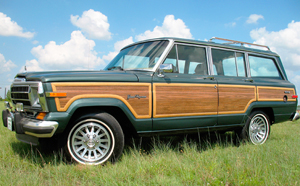
(1991 Jeep Grand Wagoneer) In its unprecedented run of 29 model years from 1963 – 1991 without any body panel changes, the Jeep “SJ body” Wagoneer / Cherokee / Grand Wagoneer appealed to a wide range of buyers.
One of the guidelines in the original Preppy Handbook (1980) reads, “Never replace anything until you have exhausted all possibility of repair, restoration, or rehabilitation. No matter what it is, they don’t make it as well as they used to.” Because true goodness will always last; and if an appealing object is worn-looking around the edges, so be it. The shabby-chic-is-better logic can apply to distressed finish on antique hutches as easily as it applies to non-matching paint on a ten-year-old Land Rover Discovery.
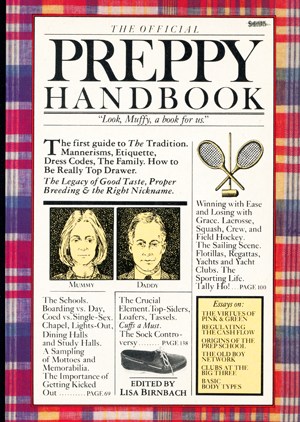
The Official Preppy Handbook listed the SJ body Jeep Wagoneer Limited as a top pick in 1980. Today, 1978-1991 SJ bodies with wider wood accents are seeing renewed interest in The Hamptons and other well-to-do areas.
While The Preppy Handbook was written as a satire, it covered a wide range of topics with accuracy, including cars – pointing out that owning at least one sport utility vehicle is a must. “What’s the point of going to the Right Places if you don’t travel in the right style? The car is as much a key part of Prep paraphernalia as a club tie or the ubiquitous duck. If, that is, it’s the Right Car – the proper make, in an accepted color, and appropriately adorned. This type of vehicle [the SUV] is essential, according to the rationale that, of course, you live in a place where the roads are private and unpaved or covered with mud.”
The Handbook was specific about what cars were The Right cars, and topping their list in 1980 was a Jeep Wagoneer Limited. Over three decades later, a Jeep Wagoneer from 1980 is probably in stronger demand now than it was new. Judging by where Jeep SJ Wagoneers can be spotted most often today, The Hamptons, Martha’s Vinyard, and Greenwich, Connecticut have some pretty bad roads apparently.
In its unprecedented run of 29 model years from 1963 – 1991 without any body panel changes, the Jeep “SJ body” Wagoneer / Cherokee / Grand Wagoneer appealed to a wide range of buyers and automotive enthusiasts – not just Preps. The Wagoneer’s design longevity is virtually unheard of to younger generations who have grown up on blob-shaped cars and trucks that have become more and more awkwardly styled and indistinguishable from one another each year.
As fans of the SJ Wagoneer, we celebrate its uniqueness and long-lasting appeal which endures today. With an American upper class growing in numbers and wealth each year, 1980s Grand Wagoneers with wood on the side have become an increasingly popular automotive accessory. Why? With Bentley, Rolls-Royce, Mercedes, Porsche, Ferrari, and other high-ticket brands all celebrating record sales years, it means those beloved Range Rovers, Mercedes G-wagens, Cadillac Escalades, and Porsche Cayennes have become run-of-the-mill to those who live the preppy credo. Jeep SJ Wagoneers have character and distinctiveness – and enthusiastic buyers hope some of that will rub off on them. Thanks to a number of restorers who specialize in these vehicles, more SJs are being brought back to showroom condition. No matter what the reason, that’s the kind of thing we appreciate seeing.
(A slideshow with high resolution pictures detailing all changes is at the end of this article)
Changes from year to year.
1963
-
Development of the Wagoneer took place over three years and cost $20 million. Upon its introduction on November 14, 1962, the first Wagoneers offered customers the greatest number of choices when it came to available body types, suspensions, and drivetrain options. When it came to market, Willys-Jeep was part of the long defunct Kaiser Motors brand which would later be purchased by American Motors Corporation (AMC) in 1970.
-
What’s commonly forgotten about Wagoneers is while they were always available as four-doors, buyers could also choose two-door versions through 1969. Most two-doors were built with windows on all sides, but a budget-priced Panel Delivery model had sheet metal in place of side windows.
-
Until April 1965, all Wagoneers were powered by a 230 cubic inch 6-cylinder engine. Advanced for its day, this 6-cylinder featured an overhead camshaft design with six cam lobes controlling the opening and closing of one intake and exhaust valve per cylinder. Named the “Tornado” engine, it featured a timing chain to drive the camshafts which kept all valves in proper synch. Since combustion chambers were shaped hemispherically, this engine could technically be described as a “hemi”.
- Buyers could choose a 3-speed manual transmission or a 3-speed automatic, both of which were produced by Borg-Warner. Either transmission could be mated to a standard rear-wheel-drive setup, or a four-wheel-drive system with manually locking front hubs. When engaged, the 4wd layout provided a rigid, zero slippage connection between front and rear axles – a setup suitable for slippery conditions and low-speed driving only. Carburetors on manual trans models were a single barrel design, and those on automatic transmission models featured two barrels.
- Early Wagoneers came with two choices of front suspension. Rear-wheel-drive vehicles intended for standard passenger use featured an independent front design allowing both wheels to articulate separately of the other via swing axles and torsion bar springs.
-
Designed by Dana, front swing axles articulated near their centers and served as the lower suspension wishbones. A strut bar was used for lateral axle control and for purposes of adjusting wheel caster angle. Upper suspension components consisted of short A-arms and ball joints connected to the torsion bars. The independent front setup was a $160 option on four-wheel-drive models, which came standard with heavy-duty front suspensions consisting of traditional solid beam axles (non-independent) with leaf springs. All rear axles featured a similar solid beam axle and leaf spring design.
1964
- Air conditioning was added as a factory option.
- A lower-compression version of the 6-cylinder engine was offered. While it made less power, it returned greater economy – ideal for Wagoneers used as work trucks or panel delivery vehicles. This lower-compression engine was phased out within a year.
1965
- In April of 1965, a V-8 engine was added as a $190 option. Sourced by American Motors, it was 327 cubic inches in displacement, came with a 2 barrel carburetor, and featured a traditional overhead valve design with hydraulic lifters.
- The V8 was available with the 3-speed manual transmission, or with a Turbo Hydramatic 3-speed automatic transmission sourced by General Motors. 6-cylinder models kept the Borg-Warner automatic.
- All 1965 models came with a new standard safety package that included front and rear seat belts, a dual-proportioned braking system, high impact window glass, padded visors, and more.
1966
-
The Super Wagoneer luxury model was introduced, and featured a new full-width grille that was more modern looking. Base models continued with the original narrow grille (through 1969).
- Super Wagoneers featured a two-tone colored section that ran along both sides as well as the rear tailgate (usually painted gold or silver). This model also came with black padded vinyl roof, air conditioning, V8, automatic transmission, whitewall tires, mag style wheel covers with simulated knock-off centers, and more luxurious padded interiors with simulated wood inserts.
1967
- Most rear-wheel-drive versions of the Wagoneer that sold slowly were dropped.
- Except for minor changes in axle ratio availability, there were no other significant changes.
1968
-
- Changes were minimal. A new Custom V8 luxury model was introduced on four-door Wagoneers.
1969
- All two-door models, including the Panel Delivery version, were dropped part way through the model year.
- Independent front suspensions were discontinued, leaving only leaf springs and solid front axles on the front and rear of all Wagoneers.
- A 350-cubic-inch Buick engine with 2 barrel carburetor replaced the American Motors 327 as the optional V-8 choice.
- The Super Wagoneer model was dropped part way through the model year.
- A 4-speed manual transmission became an option on all models across the board. The standard 3-speed manual trans now featured fully synchronized gears for smoother shifting. While the 4-speed stick was mounted on the floor, 3-speed manuals were still mounted on the steering column.
1970
- In January of 1970, American Motors bought Kaiser-Jeep mainly because of the Jeep brand’s success in the marketplace. Mechanically, all Wagoneer models were left as they were for the remainder of the 1970 model year.
-
The base model’s archaic-looking narrow grille was eliminated, and all 1970 Wagoneers featured a full-width grille with an egg crate pattern instead of vertical bars.
- Late in the 1970 model year, a power sunroof option ($490) debuted on the Custom Wagoneer and Wagoneer Custom Special.
- Wagoneer script located on the rear of 1969 models was gone. A revised 4wd badge id was placed behind the front wheel cutout.
1971
- A new Wood Grain accessory package was available on the Custom Wagoneer model, featuring simulated wood grain exterior trim, a luggage rack, and other popular interior luxury options.
- The 232 base overhead-camshaft 6-cylinder engine was replaced midyear with an American Motors 6-cylinder engine of 258 cubic inches. The new 6-cylinder featured a less-advanced pushrod setup to operate the valves.
- American Motors V-8 engines replaced the Buick 350 V-8 that had been used for 1969 and 1970. Buyers opting for eight cylinders had a choice of 304- or 360-cubic-inch versions.
- A low number of 1971 “1414 X” Wagoneers were produced for “sales promotion only”. Built mainly to use up remaining Buick V8 engines that were still in stock, 1414X Wagoneers were well equipped with Custom Wagoneer wood package, automatic transmission, 4wd, and all luxury features that came with the Custom Wagoneer model.
1972
- The Custom Special model was dropped, leaving only base and Custom Wagoneer versions.
- Front bucket seats became an option on both models.
- Changes were otherwise minimal, with a quieter Saginaw power steering pump and a larger 9-inch rearview mirror rounding out the improvements.
1973
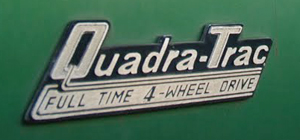 Jeep’s Quadra-Trac full-time four wheel drive system debuted as standard equipment on Wagoneers. This sophisticated system had front and rear differentials that adjusted the power and speed of the wheels they controlled. A sophisticated limited-slip center differential allowed slippage between front and rear axles, making for smooth power delivery on and off the road.
Jeep’s Quadra-Trac full-time four wheel drive system debuted as standard equipment on Wagoneers. This sophisticated system had front and rear differentials that adjusted the power and speed of the wheels they controlled. A sophisticated limited-slip center differential allowed slippage between front and rear axles, making for smooth power delivery on and off the road.
- The smaller 304 V-8 engine was no longer available for 1973, and the 360 V-8 was now available with a 4 barrel carburetor that made 195 horsepower compared to 175 for the 2 barrel setup.
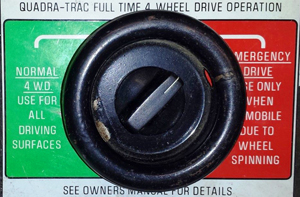 As either a dealer-installed or factory option on 4wd models, a low range gearing assembly was fitted to the center transfer case at the end of the transmission main shaft. A knob on the dash to the right of the steering column controlled the change between the low 2.75:1 gearing and normal driving 1:1 ratio.
As either a dealer-installed or factory option on 4wd models, a low range gearing assembly was fitted to the center transfer case at the end of the transmission main shaft. A knob on the dash to the right of the steering column controlled the change between the low 2.75:1 gearing and normal driving 1:1 ratio.
- 3-speed manual gear shift levers were moved from the steering column to the floor this year.
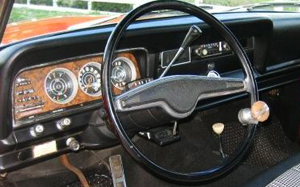 Dashboard design was modernized, with a three-section cluster housing the speedometer and other gauges. All control knobs were of a more luxurious “soft feel” texture, and steering wheels were revised.
Dashboard design was modernized, with a three-section cluster housing the speedometer and other gauges. All control knobs were of a more luxurious “soft feel” texture, and steering wheels were revised.
- Clutch linkages for the manual transmission models were redesigned for smoother gear shift operation, and front axles were beefed up along with 4wd propeller shafts for longer life.
1974
- With the Wagoneer becoming increasingly popular among well-heeled buyers, Jeep sought to move it further upmarket with more content and higher sticker prices. In order not to lose buyers in the lower price range who cross shopped Ford Broncos and Chevrolet Blazers, Jeep created the Cherokee model – basically a down market, two-door version of the Wagoneer. Other than number of doors, body panels were the same on both models.
-
The standard Wagoneer engine was no longer a 6-cylinder, but a 360 cubic inch V-8 with two barrel carburetor (175 horsepower). Cherokees had the 6-cylinder standard, but could option up to the Wagoneer standard V-8. Both models could opt further for a 4-barrel version of the 360 (195 hp), or a 401 cubic inch V-8 with 4-barrel carb (215 hp). Wagoneers received freer-flowing exhaust systems to aid fuel economy.
- 15-inch aluminum wheels became available for both Wagoneer and Cherokee.
-
The new Cherokee was offered in two versions, the base model and S (Sport) version. Base Cherokees had black window moldings, painted bumpers, dog dish center hub caps, rubber floor mats, and bench seats. Cherokee S models came with fancier side body and lower tape striping, bright window moldings, chrome bumpers, aluminum wheels, roof rack, and more interior features standard.
- Larger bumpers were fitted across the board in order to comply with U.S. government regulations specifying no damage on impacts up to 5 mph. While they are visibly larger, the difference to the eye is a subtle one.
- Disc brakes had never been offered before on any Jeeps, but this year Wagoneers were upgraded to standard front disc brakes. While Cherokees still had 4 wheel drum brakes standard, front discs could be had for an extra $65.
- Four-wheel-drive Wagoneers and Cherokees were fitted with 6-bolt wheels instead of 5-bolt wheels. Wheel diameter remained at 15 inches, as it had been since 1963.
1975
- All Wagoneer and Cherokee engines got new electronic ignition systems that reduced fuel consumption.
- Redesigned 5-leaf springs were featured on all models. To improve ride quality, rear springs had a new progressive-rate design with longer shock absorbers mounted in a staggered position.
-
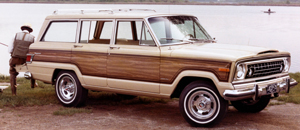
1975 Jeep Custom Wagoneers were available with a wider section of wood trim for the first time. While this was discontinued for 1976, the wider wood trim made a return in mid-1978.
Custom Wagoneers were available with a wider section of simulated wood trim on the sides and rear. While this larger wood design only lasted one model year, it would return during 1978 with a slightly different grain. It’s interesting to note how much the wood grain patterns improved over the years.
1976
-
A new “Cherokee Chief” package on the Sport model became available. To add a rugged look, exterior trim consisted of low-gloss black tape and decals, with black plastic wheel opening molding pieces. Tires were larger and beefier, and rear wheel openings on the Chief were more cut out and exposed than they were on other Cherokees and Wagoneers.
- A new “wide wheel and tire package” package for the Cherokee Chief included flared fenders around the wheel openings as well as 10-inch wide wheels and 3.54:1 axle ratio.
- The exterior wood trim on Custom Wagoneer models reverted back to its smaller, more conservative pre-1975 form this year.
- All Wagoneer and Cherokee models received beefed up frames with stronger cross members and boxed side rail construction. New heavy-duty springs were offered on both models for those who ventured further off road.
-
- All Cherokees received standard bucket seats instead of a bench. Chief models got front disc brakes, power steering, and fuel tank skid plate as standard equipment.
1977
- A four-door Cherokee model was introduced for 1977, with body panels identical to Wagoneers. While a Sport Package was offered on the four-door, the Cherokee Chief remained as a package for two-doors only.
- Instead of base and Custom Wagoneers, only one model of the Wagoneer was available for 1977. While it was unlabeled, it mirrored the higher luxury content of the previous year’s Custom model.
- Base model Cherokees received power front disc brakes as standard equipment, and the single barrel carburetor on the base 6-cylinder Cherokee engine was replaced by a standard 2-barrel unit.
- Spare tires on Wagoneers and Cherokees were switched from a horizontal position underneath the rear of the vehicle to being vertically mounted inside the rear storage area.
1978
- The Wagoneer’s standard 360-cubic-inch V-8 engine now featured the 4-barrel carburetor standard in place of the 2-barrel.
-
A new Wagoneer “Limited” luxury was introduced midway through the model year. According to Jeep literature, the Limited was “A cut above excellence…built for the man who demands the ultimate in four-wheel-drive performance without compromising on luxury”. Priced 40 percent higher than the main Wagoneer model, the Limited came with every conceivable luxury option.
- Interestingly, the wider exterior wood trim that made a brief appearance on 1975 Custom Wagoneers made a return on the Limited, providing a most stylish look that would remain intact through 1991. Wagoneer Limited featured unique aluminum wheels with ten small round holes which would be used for 1979 also.
1979
-
All Wagoneer and Cherokee models received a substantial styling update with square headlights and a new grille which emphasized horizontal slats. This front end look would stay with the SJ body through 1991.
- Neither the 401 cubic inch V-8 or 360 4-barrel V-8 engines were offered for 1979. Focusing on fuel economy, the top engine was now the 360 2-barrel which made a reduced 155 horsepower. This was standard on Wagoneers and optional on Cherokees.
- Wagoneer models got one-piece aluminum bumpers to further enhance mileage by weight reduction.
- Other than the changes referenced above, Wagoneer Limited models remained unchanged from 1978.
-
Cherokee two- and four-door models were carried over from 1978. Cherokee two-doors with the wide wheel and tire flared fender package could select a new “Golden Eagle” trim option. Similarly equipped as the Cherokee Chief trim option, the Golden Eagle differed only in exterior colors and decals.
1980
-
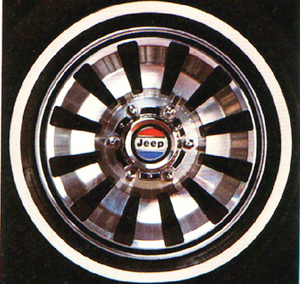
Wagoneer Limited models featured this new design of forged aluminum wheels with a turbine fin design that became the norm through mid-1987.
Wagoneer Limited models featured a new design of forged aluminum wheels with a turbine fin design that became the norm through mid-1987.
After the second fuel crisis of the decade hit during the summer of 1979, Jeep product planners focused even further on gas mileage. While the 360 V8 was carried over as standard on the Wagoneer, buyers could also delete that in lieu of the inline 6-cylinder engine which had been around for a decade. This would be the first time since 1973 that a Wagoneer could be had with six cylinders.
- Replacing both the 3-speed Borg-Warner manual transmission and the optional 4-speed manual was a new Tremec 4-speed manual designed with a weight-saving aluminum housing. While this transmission was naturally standard on Cherokee models, it was also available with the 6-cylinder engine in Wagoneers if a buyer wanted it.
- This year, Wagoneers could now also be ordered with a part-time 4-wheel-drive system – a first since the QuadraTrac full-time system debuted on 1974 models. This offered a gain in fuel economy compared to full-time 4wd.
-
A new steering wheel design with three prongs ran from 1980 through 1981.
- An updated QuadraTrac full-time 4wd system featured a limited slip differential that used a viscous fluid coupling instead of the cone-clutch system used through 1979. This offered reduced wear and smoother operation. This system could be ordered on Cherokees and Wagoneers.
- This year, a lighter “Torque Flite” 3-speed automatic transmission sourced by Chrysler replaced the previous General Motors automatic. This would be retained through the end of SJ body production in 1991.
- Cherokee two-doors with the wide wheel and tire flared fender package could select a new “Laredo” trim option. Similarly equipped as Cherokee Chief and Golden Eagle packages, the Laredo differed primarily in exterior colors and decals.
- Wagoneer Limited models featured a new design of forged aluminum wheels with a turbine fin design that became the norm through mid-1987. Wheels on Wagoneer Custom and Brougham models (shown here) were borrowed from the CJ-7 for 1980-82.
1981
-
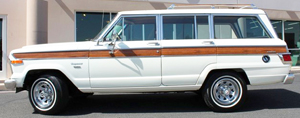
Jeep Wagoneer Custom models looked like this through 1982. Wheels on Custom and Brougham models (shown here) were borrowed from the CJ-7.
The 1981 Wagoneer line was expanded to include three levels: Custom, Brougham, and Limited. Custom and Brougham models featured less wood, if any, while the Limited maintained its status quo.
- This year, the 360 V-8 actually became an option for all Wagoneers because the official base engine was now the 6-cylinder across the board. The six had seen numerous improvements including a weight reduction of 90 pounds through aluminum components and removal of mass from the engine block.
-
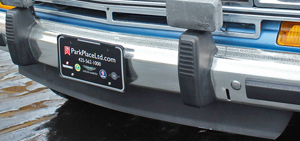
To enhance fuel economy, 1981 and later models featured a front airdam fitted below the front bumper to reduce drag underneath the vehicle.
To further enhance fuel economy, a front airdam was fitted below the front bumper of all Wagoneers and Cherokees to reduce wind resistance underneath. Redesigned front and rear springs lowered ride height to reduce wind resistance overhead. New, drag-free brake calipers retracted back in further so no brake pad rub would occur when brakes weren’t being applied.
- The Chrysler-sourced 3-speed automatic transmission was now equipped with a lockup torque converter – eliminating slippage once the vehicle reached a steady speed.
- To reduce engine rpms, all Wagoneer and Cherokee models were given more relaxed final gearing in axle ratios and in the first gear of manual transmissions.
-
A new Chief package was introduced on four-door Cherokees. In fact, all four-door Cherokees were now badged as Chief models. The Chief package was optional on the base two-door and wide wheel package two-door.
1982
-
All models received new halogen headlights as standard equipment.
- Steering wheels and dashboards were updated for 1982.
-
- An optional Tremec 5-speed manual transmission with overdrive was new this year, available on Cherokees and Wagoneer Custom models with part-time 4wd only. Wagoneer Brougham and Limited models now had the 3-speed automatic standard.
1983
- A new “Selec-Trac” part time 2wd/4wd system was introduced as standard on Wagoneers and optional on Cherokees. Selec-Trac low range was engaged only when the vehicle was in 4wd since a sequential lockout system within the transfer case prevented low range operation in 2wd mode. A floor-mounted lever controlled engagement in and out of Low range, which was done only when the vehicle was stopped.
- The 258-cubic-inch 6-cylinder engine’s compression ratio was bumped back up this year for more power, and a fuel feedback system and knock sensor were added to improve performance and efficiency. This was still the standard engine on all Cherokee and Wagoneer models.
- The Wagoneer line was reduced to Brougham (no exterior wood trim) and Limited (wood trim) models. All Wagoneers came only with the 3-speed automatic now, and this would continue on Grand Wagoneers through 1991.
- This was the final model year that Cherokees were Wagoneer clones, as they were redesigned on a smaller unibody chassis for 1984. A new “Pioneer” package was standard on the four-door and optional on the two-door. Cherokee Chief and Laredo packages continued, but were only offered on widewheel two-doors only.
1984
-
With Cherokee and Wagoneer models being moved onto a new smaller platform, the old SJ body style continued on in one offering which was renamed the “Grand Wagoneer”. In price and content, it was equivalent to the Wagoneer Limited and included virtually every luxury option.
-
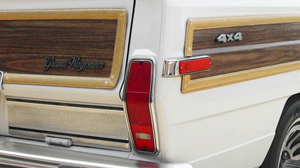
Revised tail lights on 1984-1991 Grand Wagoneers were borrowed from Cherokee models, and looked like this.
Grand Wagoneer tail lights were no longer like the Wagoneer ones which had always wrapped around the rear corners. Like the Cherokee tail lights, they were narrow and vertical on the tailgate panel only.
- 1984 Grand Wagoneer sales reached 19,081 – a number that virtually tied 1983 model Wagoneer sales of 19,155.
-
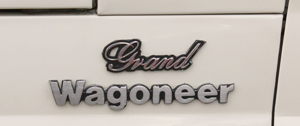
A Grand Wagoneer without wood trim was offered for 1984. Due to slow sales, it did not survive into 1985.
Grand Wagoneer engine choices were unchanged from 1983. The 6-cylinder was standard, with the 360 V-8 optional.
- A Grand Wagoneer without wood trim was offered for 1984. Due to slow sales, it did not survive into 1985.
1985
-
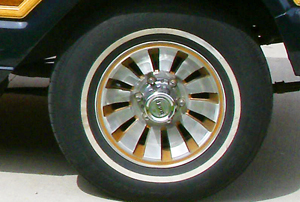
Standard forged aluminum wheels featured gold paint between each fin on 1985 and 1986 Grand Wagoneers.
A “Handling Package” was added to Grand Wagoneers this year to provide a smoother, more comfortable ride.
- The Selec-Trac 4wd system now offered shift on the fly capability.
- 15” x 7” standard forged aluminum wheels now featured gold paint between each fin. These gold wheels would last through 1986.
- New for 1985 was a moveable center armrest that retracted so three adults could sit across front bucket seats, and headrests were adjustable.
1986
-
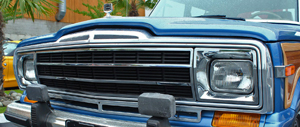
1986 Grand Wagoneers received this redesigned grille and hood ornament. Both would last through 1991.
Grand Wagoneers got a redesigned grille that would last through 1991. Two main horizontal bars divide the grille into three sections.
- Grand Wagoneers all received a new stand-up hood ornament.
- Dashboards and interiors were redesigned with a more modern look that included integrated controls for the air conditioner and heater/defrost systems. This interior look would remain through 1991.
-
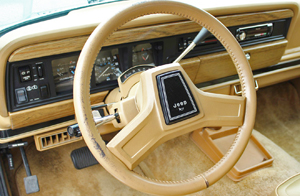
Dashboards and interiors were redesigned with a more modern look, as seen here. This would continue through 1991.
Standard full-time Selec-Trac 4wd system had a new Trak-Lok limited slip differential that shifted power to the wheel(s) with the best traction.
1987
-
The base 6-cylinder engine was dropped, leaving the AMC 360 V-8 as the standard powerplant for the Grand Wagoneer through 1991.
- Chryler purchased AMC/Jeep in March of 1987 but left the Grand Wagoneer basically as it was because the profit margin per vehicle was a respectable $5,000 to $6,000.
-
Wheels were revised for the 1987 model year. They featured more open spokes that were less like the turbine fin blade look introduced for 1980. These wheels would last through 1991.
- The exterior featured revised woodgrained sides in English Walnut with new nameplates and V8 badges. On the inside were new tan or cordovan trims that replaced the honey and garnet colors, while the interior assist pulls on the door panels were removed.
1988
-
- A new electric sunroof featured a built-in air deflector and venting capability. Otherwise, changes were minimal.
1989 through 1991
-
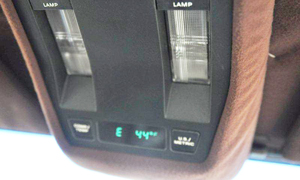
An interior overhead console with lights, outside temp reading, and electronic compass was added for 1989.
The 1989 model year saw a redesigned a/c compressor that corrected an older design prone to leakage and failure.
- Chrysler oversaw a general improvement in fit and finish on Grand Wagoneers during these years. An interior overhead console, borrowed from Chrysler’s own minivans, was also added for 1989. This functional console featured much brighter map lights, an outside temperature sensor, compass, and an infrared remote keyless entry system.
- These last three model years also featured new paint colors that included the rare and favored Hunter Green metallic that became available for 1991. Of interest, Hunter Green is the color of the 1991 Grand Wagoneer in the Chrysler museum, as well as the color of the very last Grand Wagoneer ever made (produced June 21, 1991) that’s on display at the National Automobile Museum.
-
Whereas Wagoneer production through the 1980-1990 model years tended to run from 10k to 20k units annually, only 1,560 Grand Wagoneers were produced for the final 1991 model year. Owners had the option of having a “Final Edition Jeep Grand Wagoneer” badge on the dashboard.
CLICK ON ANY OF THE PICTURES IN THE SLIDE SHOW BELOW TO EXPAND TO FULL SIZE. USE ARROWS UNDERNEATH PICTURES TO SCROLL BACKWARD OR FORWARD.
- In its unprecedented 29 model year run from 1963 – 1991 without any body panel changes, the Jeep “SJ body” Wagoneer / Cherokee / Grand Wagoneer appealed to a wide range of buyers and automotive enthusiasts. Today, 1978-1991 SJ bodies with wider wood accents are seeing renewed interest.
- Development of the Wagoneer took place over three years and cost $20 million. Upon its introduction on November 14, 1962, the first Wagoneers offered customers the greatest number of choices when it came to available body types, suspensions, and drivetrain options.
- What’s commonly forgotten about Wagoneers is while they were always available as four-doors, buyers could also choose two-door versions through 1969.
- Most two-door Wagoneers were built with windows on all sides, but a budget-priced Panel Delivery model (shown) had sheet metal in place of side windows. The Panel Delivery was dropped during 1969.
- 1963 Jeep Wagoneer advertisement
- 1963 Jeep Wagoneer advertisement
- Early Wagoneers came with two choices of front suspension. Rear-wheel-drive vehicles intended for standard passenger use featured an independent front design allowing both wheels to articulate separately of the other via swing axles and torsion bar springs.
- Visible in this picture on the left side of the vehicle are the rear leaf springs and solid beam axle that all SJ Wagoneers came with. Spare tires were underneath the vehicle.
- Here, a 1965 Wagoneer is seen at that year’s Detroit International Auto Show.
- This 1965 Jeep Wagoneer ad extolls the virtues of 4-wheel-drive.
- The Super Wagoneer luxury model was introduced, and featured a new full-width grille that was more modern looking. Base models continued with the original narrow grille (through 1969).
- Super Wagoneer models featured black padded vinyl roof, air conditioning, V8, automatic transmission, whitewall tires, mag style wheel covers with simulated knock-off centers, and more luxurious padded interiors with simulated wood inserts.
- 1966 Jeep Wagoneer 4×4 advertisement
- 1967 Jeep Wagoneer advertisement
- Most Jeep Wagoneers through 1968 were equipped with these center hub caps. More luxurious models featured an additional outer trim ring.
- Higher-end Wagoneers received this design of one-piece full wheel covers from 1969 through 1975.
- This 1970 Wagoneer ad shows the new grille that all Wagoneers got for 1970. Also visible are the full wheel covers shown in the previous picture
- A new Wood Grain accessory package was available on the Custom Wagoneer model, featuring simulated wood grain exterior trim, a luggage rack, and other popular interior luxury options. (1972 model shown)
- Jeep’s Quadra-Trac full-time four wheel drive system debuted as standard equipment on Wagoneers. This sophisticated system had front and rear differentials that adjusted the power and speed of the wheels they controlled. A sophisticated limited-slip center differential allowed slippage between front and rear axles, making for smooth power delivery on and off the road.
- 1973 Jeep Wagoneer base model. Notice the lack of chrome trim around the door frames.
- With the Wagoneer becoming increasingly popular among well-heeled buyers, Jeep sought to move it further upmarket with more content and higher sticker prices. In order not to lose buyers in the lower price range who cross shopped Ford Broncos and Chevrolet Blazers, Jeep created the Cherokee model – basically a down market, two-door version of the Wagoneer. The “S” model in the foreground has new-for-’74 aluminum wheels.
- 1974 Jeep Wagoneer base and Custom models. The standard Wagoneer engine was no longer a 6-cylinder, but a 360 cubic inch V-8 with two barrel carburetor (175 horsepower). Cherokees had the 6-cylinder standard, but could option up to the Wagoneer standard V-8.
- 1975 Jeep Cherokee
- 1975 Jeep Custom Wagoneers were available with a wider section of wood trim for the first time. While this was discontinued for 1976, the wider wood trim made a return in mid-1978.
- A new “Cherokee Chief” package on the Sport model became available for 1976. To add a rugged look, exterior trim consisted of low-gloss black tape and decals, with black plastic wheel opening molding pieces. Tires were larger and beefier, and rear wheel openings on the Chief were more cut out and exposed than they were on other Cherokees and Wagoneers.
- As seen here, the exterior wood trim on 1976 Custom Wagoneer models reverted back to its smaller, more conservative pre-1975 form.
- For 1976, this wheel cover design replaced the previous one. They were used in the U.S. market until 1979 and in other markets through 1983.
- A 4-door Jeep Cherokee was introduced for the 1977 model year. It shared all body panels with the Wagoneer, but chrome trim around the windows was missing.
- A new Wagoneer “Limited” luxury model was introduced midway through the 1978 model year. With the return of wider wood sections, it was priced 40 percent higher than the main Wagoneer model.
- This 1979 Wagoneer Limited ad illustrates how the Limited came with every conceivable luxury option.
- 1979 Jeep Wagoneer Limited. All Wagoneer and Cherokee models received a substantial styling update with square headlights and a new grille which emphasized horizontal slats.
- 1979 Jeep Wagoneer Limited advertisement.
- 1979 Jeep Cherokee “S” Sport model with decals and aluminum wheels.
- 1979 Jeep Cherokee, base model.
- 1979 Jeep Wagoneer Custom
- For 1980, Wagoneer Limited models featured a new design of forged aluminum wheels with a turbine fin design that became the norm through 1986.
- The 1981 Wagoneer line was expanded to include three levels: Custom, Brougham, and Limited (shown). Custom and Brougham models featured less wood, if any, while the Limited maintained its status quo.
- In some non-U.S. markets, Wagoneers were re-badged Cherokees. Note the Cherokee grille and trim with the Wagoneer badge. This was the final model year that Cherokees were Wagoneer clones, as they were redesigned on a smaller unibody chassis for 1984.
- 1983 Jeep Wagoneer ad. A new “Selec-Trac” part time 2wd/4wd system was introduced as standard on Wagoneers and optional on Cherokees. Selec-Trac low range was engaged only when the vehicle was in 4wd since a sequential lockout system within the transfer case prevented low range operation in 2wd mode. A floor-mounted lever controlled engagement in and out of Low range, which was done only when the vehicle was stopped.
- 1983 Wagoneer Limited ad.
- For 1983, the Wagoneer line was reduced to Brougham (no exterior wood trim) and Limited (wood trim) models. All Wagoneers came only with the 3-speed automatic now, and this would continue on Grand Wagoneers through 1991.
- Tail lights on SJ Wagoneers through 1983 looked like this.
- Revised tail lights on 1984-1991 Grand Wagoneers were borrowed from Cherokee models, and looked like this.
- With Cherokee and Wagoneer models being moved onto a new smaller platform, the old SJ body style continued on in one offering which was renamed the “Grand Wagoneer”. In price and content, it was equivalent to the Wagoneer Limited and included virtually every luxury option.
- 1985 Grand Wagoneer ad.
- 15” x 7” standard forged aluminum wheels now featured gold paint between each fin. These gold wheels would last through 1986.
- A wider view of a Jeep Grand Wagoneer with the gold laced wheels shown in the prior photo.
- 1986 Grand Wagoneers received this redesigned grille and hood ornament. Both would last through 1991
- A closer view of the standard hood ornament on all 1986-91 Jeep Grand Wagoneers.
- For 1986, Grand Wagoneer dashboards and interiors were redesigned with a more modern look, as seen here. This would continue through 1991.
- A closer look at the new-for-1986 Jeep Grand Wagoneer instrument cluster.
- New forged aluminum wheels of this design were standard on all 1987 – 1991 Grand Wagoneers.
- A lighter color woodgrain was used for 1987-91 Grand Wagoneers. (1988 model shown here)
- 1987 Jeep Grand Wagoneer
- 1988 Jeep Grand Wagoneer.
- 1988 Jeep Grand Wagoneer.
- 1988 Jeep Grand Wagoneer
- 1988 Jeep Grand Wagoneer 4×4 badge on rear fender.
- For 1989, an interior overhead console was added. Borrowed from Chrysler’s own minivans, this functional console featured much brighter map lights, an outside temperature sensor, compass, and an infrared remote keyless entry system.
- Through the entire SJ body production run, power lock and window switches were on the driver’s door.
- For 1983, a new “Selec-Trac” part time 2wd/4wd system was introduced as standard on Wagoneers and optional on Cherokees.
- 1983-1991 Selec-Trac low range was engaged only when the vehicle was in 4wd since a sequential lockout system within the transfer case prevented low range operation in 2wd mode. A floor-mounted lever controlled engagement in and out of Low range, which was done only when the vehicle was stopped.
- The leather interior of a typical Jeep Grand Wagoneer (1988 model shown).
- The leather rear seats of a typical Jeep Grand Wagoneer (1988 model shown).
- The rear cargo area of a typical Jeep Grand Wagoneer (1988 model shown).
- With headliners like this, it’s not hard to see why the SJ body Wagoneers perpetually appeal to those who follow the credo of the Preppy Handbook.
- The roof rack of a typical Jeep Grand Wagoneer. (1988 model shown)
- This concept study shows how a modern Grand Wagoneer could look. Top Chrysler executives have pledged to bring the model name back as a 7-seat luxury SUV. We hope they mean what they say.

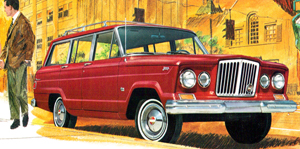
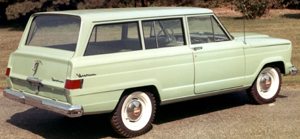
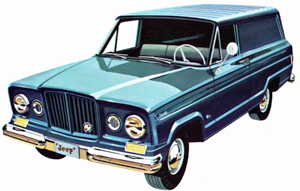
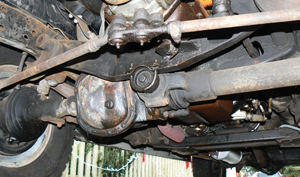
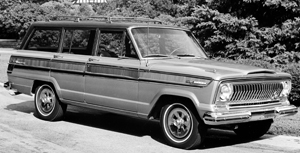
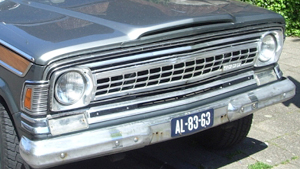
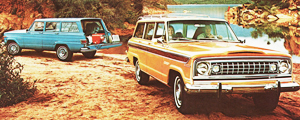
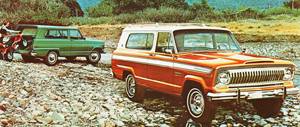
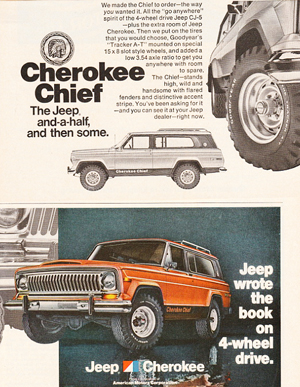
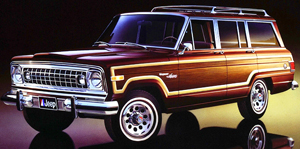
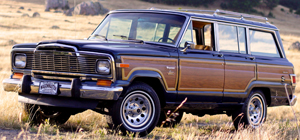
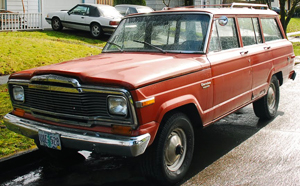
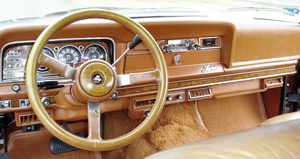
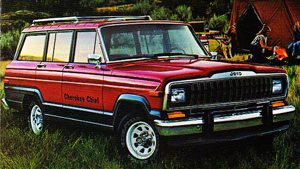
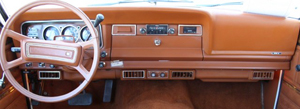
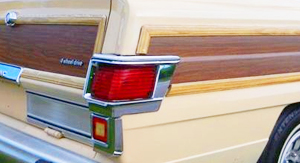
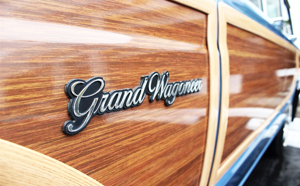
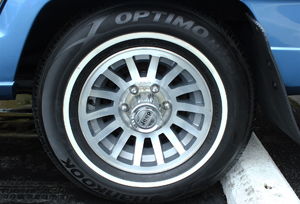
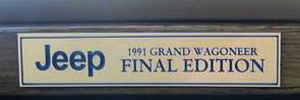
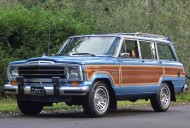

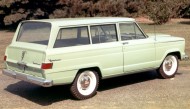
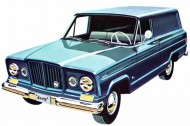
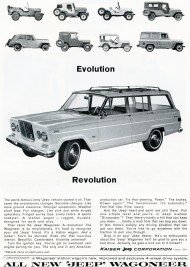
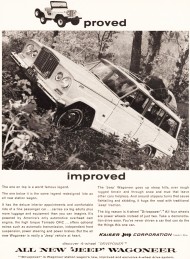
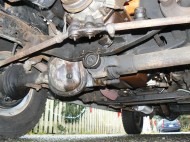
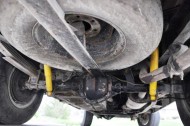
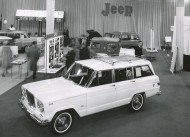
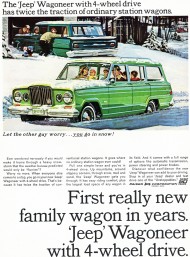
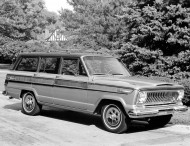
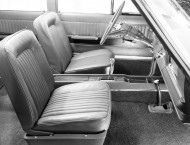
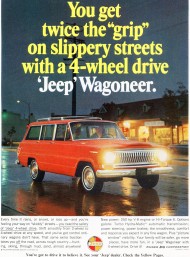
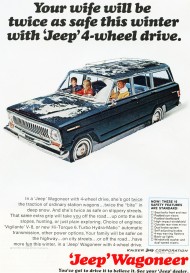
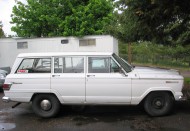
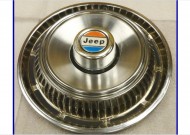
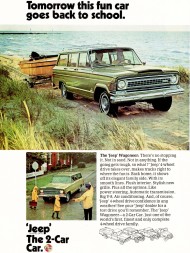
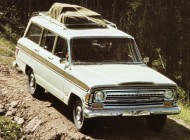
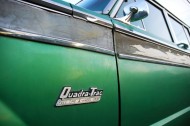
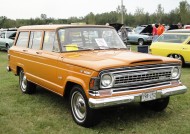
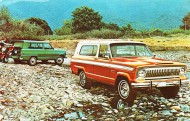
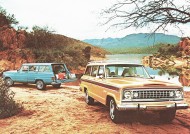
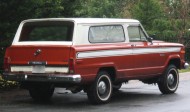
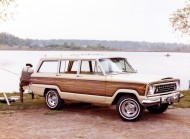
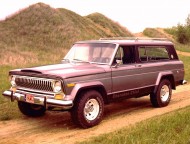
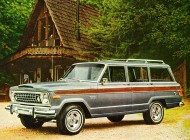
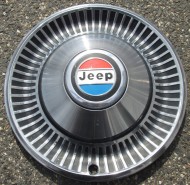
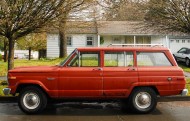
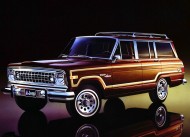
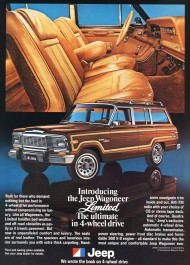
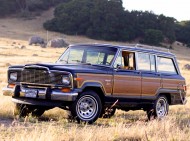
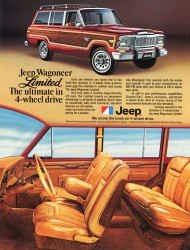
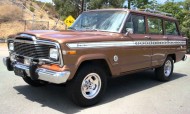
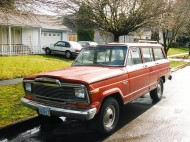
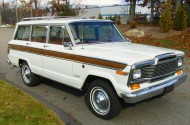
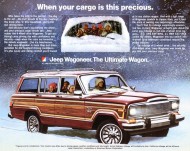
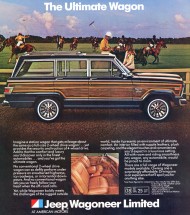
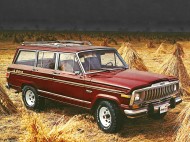
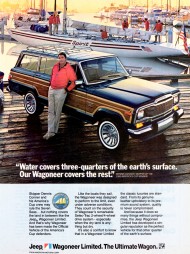
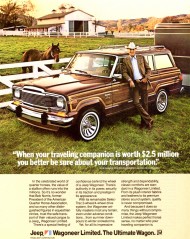
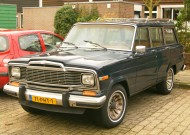
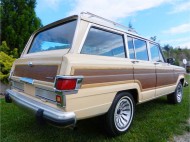
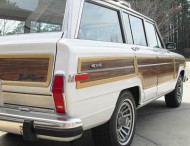
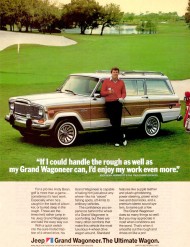
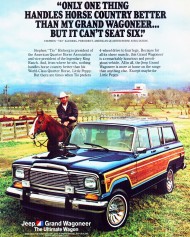
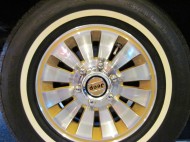
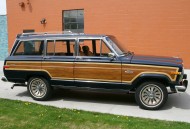
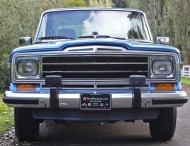
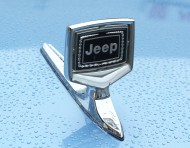
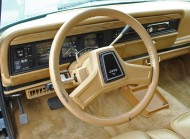
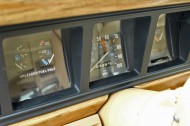
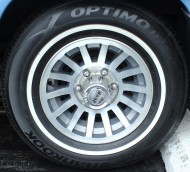
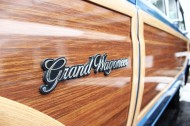
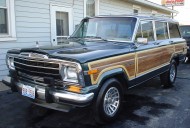
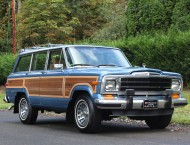
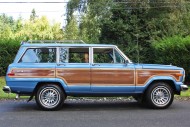
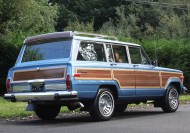
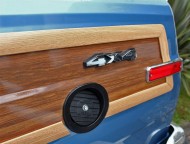
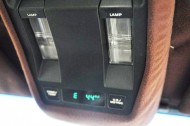
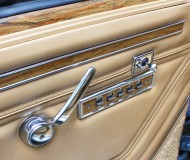
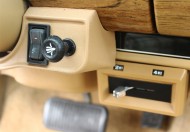
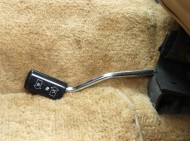
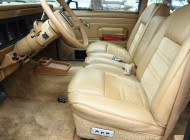
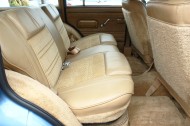
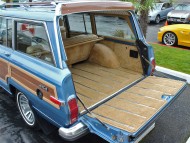
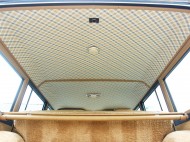
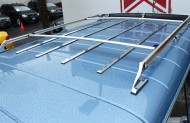
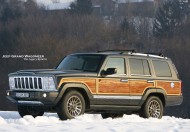
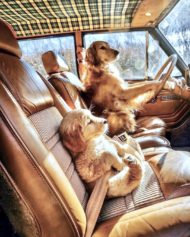

































Impressive work, i agree except for 68 and 69 : the 350 buick replaced the 327 and the two doors and 2WD wagoneers were discontinued in 1968. The IFS was discontinued earlier in 1965.
love this. the Preppy handbook was my guide “back in the day”